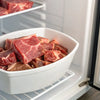How to Defrost Raw Dog Food Fast: A Complete Guide for Pet Owners
- Houndsy
Table of Contents
- Introduction
- Understanding Raw Dog Food
- Methods for Defrosting Raw Dog Food
- Tips for Proper Defrosting
- Keeping Your Pet Safe During Feeding
- Conclusion
Introduction
Have you ever found yourself in a pinch, staring at a frozen block of raw dog food minutes before mealtime, and wondering how to defrost it fast? You’re not alone; it’s a common circumstance that can lead to anxiety for many pet owners. With 68% of U.S. households owning a pet, the demand for quick solutions without compromising our furry friends' health is higher than ever. Learning how to properly defrost raw dog food is essential not only for convenience but for ensuring your pet’s health and safety.
In this blog post, we’ll explore various methods to safely and efficiently defrost raw dog food. We’ll discuss the risks associated with improper thawing techniques, like using a microwave or leaving the food out at room temperature. Most importantly, we’ll provide practical solutions that you can easily integrate into your daily routine, making mealtimes smoother. By the end of this article, you’ll feel confident in your ability to thaw your dog's food quickly and safely.
So, how do we navigate this essential aspect of pet care? Together, we’ll detail the safest and quickest options for defrosting your dog's meals, backed by expert insights and practical tips. Let’s dive into the world of raw feeding and ensure every meal is a delightful experience for both you and your pet!
Understanding Raw Dog Food
The Benefits of Raw Diet
Switching to a raw diet for our dogs can come with various benefits, ranging from better digestion to improved coat health. Raw dog food typically consists of whole meats, bones, fruits, and vegetables. This diet aims to mimic what our pets would consume in the wild, allowing them to thrive on a natural, balanced diet.
- Nutritional Value: Raw food diets are rich in protein, essential fatty acids, and vitamins that contribute to overall health.
- Fewer Allergies: Many dog owners report fewer allergy-like symptoms when feeding their pets raw food, resulting in healthier skin and fur.
- Better Teeth: Chewing on raw bones can help reduce plaque buildup, enhancing dental health.
These benefits can make embracing a raw diet for our dogs an attractive option. However, it brings along the challenge of proper preparation, especially when it comes to safe defrosting.
Importance of Safe Defrosting
Primarily, the goal of defrosting raw dog food lies in preventing bacterial growth and maintaining nutritional integrity. Undoubtedly, raw food requires careful handling to ensure we're serving a safe meal to our pets. Choosing the wrong defrosting method could lead to foodborne illnesses, compromising your pet's health. This makes it critically important to learn how to defrost raw dog food effectively.
Methods for Defrosting Raw Dog Food
The Refrigerator Method
Best Practice for Safety
When discussing how to defrost raw dog food fast, the refrigerator method is the gold standard. While it's the slowest option, it is undoubtedly the safest and most nutritious way to thaw your pet’s meals.
- Timeline: Generally, raw dog food will thaw in approximately 12-24 hours, depending on the amount. A single serving can usually be ready overnight, while larger packages may take longer.
-
Steps:
- Plan ahead by removing the correct portion of raw dog food from the freezer.
- Place it in an airtight container to prevent any cross-contamination.
- Store it on the bottom shelf of your refrigerator.
This method ensures that your food remains at a safe temperature, preventing bacterial growth, and retains the nutrients essential for your dog's health.
The Cold Water Method
Quick Yet Safe
If you find yourself needing to defrost food at the last minute, the cold water method can work wonders.
-
How It Works:
- Ensure the raw food is in a leak-proof bag to prevent water from infiltrating the food.
- Submerge the bag in a bowl or sink filled with cold water, changing the water every 30 minutes to maintain its chill.
-
Timeline: Expect approximately 30 minutes to 1 hour for thawing, depending on the size of the food portion.
This method helps maintain food safety, although it requires periodic monitoring. Still, it’s a significant improvement over other less sanitary methods!
The Microwave Method: What to Avoid
Risks Involved
It’s tempting to use the microwave for quick defrosting, but we strongly advise against it. While microwaving appears convenient, it presents several risks:
- Bacterial Growth: Microwaves can create hot spots that allow bacteria to flourish.
- Cooked Food: There’s a risk of partially cooking your dog's food, which can alter nutritional composition and may lead to hazardous splintered bones.
This method undermines the very principles of raw feeding, which is aimed at providing unaltered, nutritious food for our pets.
Leaving Raw Food Out at Room Temperature
Not Recommended
While some owners consider leaving raw food at room temperature for a quicker thawing, this method is fraught with danger. Leaving raw meat out creates an environment conducive to bacterial growth, posing health risks not only for the pet but for any humans interacting with it.
- Danger Zone: Bacteria multiply rapidly at temperatures between 40°F and 140°F. Foods left in this range for too long could lead to food poisoning.
To protect both your pet and your family, we recommend steering clear of this defrosting strategy.
Tips for Proper Defrosting
Portion Control
To simplify your raw feeding routine, consider breaking larger packages of raw food into single-serve portions at the outset. This allows you to defrost only what you need, diminishing waste and reducing the chances for bacterial growth.
Planning Ahead
To maintain a seamless feeding schedule, integrate a simple habit of moving frozen food into the fridge the night before. This bit of foresight can save you from many last-minute rushes and nutritional missteps.
Emergency Quick-Feed Solutions
Having a backup on hand can save you from scrambling when you’re in a tight spot. Freeze-dried raw foods or pre-packaged meals can offer convenient options without the need for preparation or thawing.
Keeping Your Pet Safe During Feeding
Hygienic Practices
Maintaining cleanliness during raw feeding is crucial. Follow these tips to ensure a safe environment for both you and your pet:
- Wash Your Hands: Always wash your hands thoroughly after handling raw food.
- Sanitize Surfaces: Clean any surfaces that come in contact with raw meat to avoid cross-contamination.
Serving with Care
Once your dog’s raw food is fully thawed, we recommend serving it immediately. Monitor your pet while they eat, and avoid leaving raw food out for prolonged periods—anything left over should be discarded.
Conclusion
Defrosting raw dog food safely and efficiently is an essential skill that contributes to the overall well-being of your pet. By understanding the various methods available—from refrigerator thawing to cold water submersion—you can ensure that mealtime remains a safe and nourishing experience.
With some careful planning and an awareness of hygiene, you’ll be equipped to handle your dog’s raw feeding needs confidently. We encourage you to explore more about incorporating products that can simplify this process, such as the Houndsy Kibble Dispenser, which beautifully blends design with functionality to elevate your dog feeding experience.
FAQs
How long can I keep defrosted raw dog food in the fridge? Defrosted raw dog food can safely remain in the fridge for up to 3 days. Always check for freshness before serving.
Can I refreeze food that has been thawed? If the food remains cold to the touch after thawing, it can be refrozen. However, it's best not to do this repeatedly as it may affect quality.
What if I forget to take the food out the night before? If you need a quick solution, use the cold water method, ensuring to frequently check the food to limit bacterial growth.
Can I thaw raw dog food in hot water? Using hot water is highly discouraged as it can create a “danger zone” for bacterial growth and may damage the nutritional integrity of the food.
Is it okay to feed frozen raw food to my dog? While it’s generally recommended to fully thaw raw food, some dogs may enjoy frozen food as an occasional treat. However, consult your veterinarian if you have concerns.
Your proactive approach towards defrosting raw dog food can make you a more informed pet owner. Together, let’s prioritize our pets’ health and happiness!













